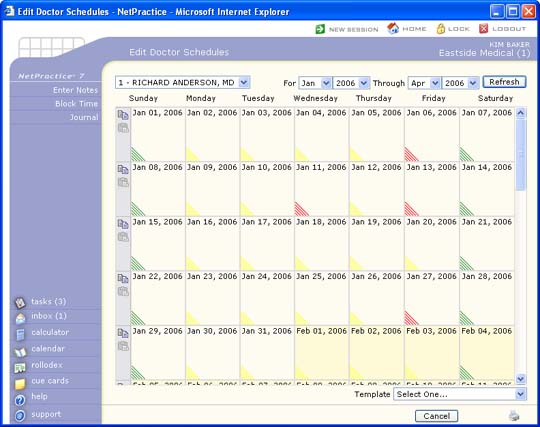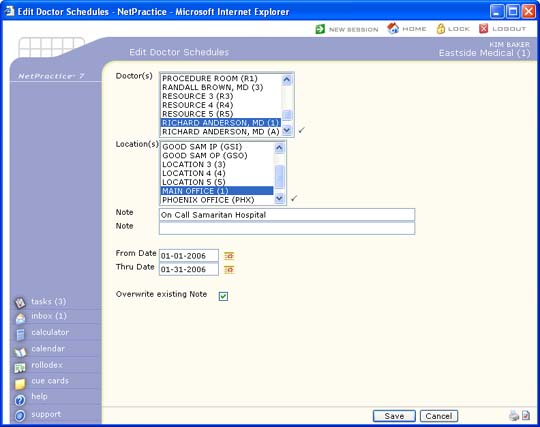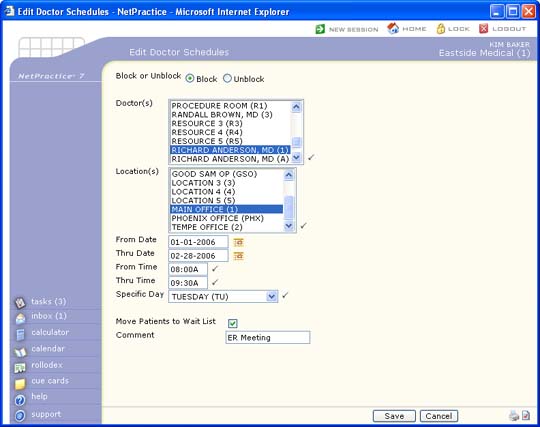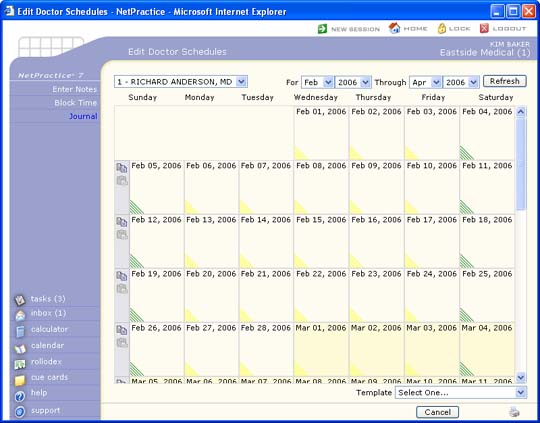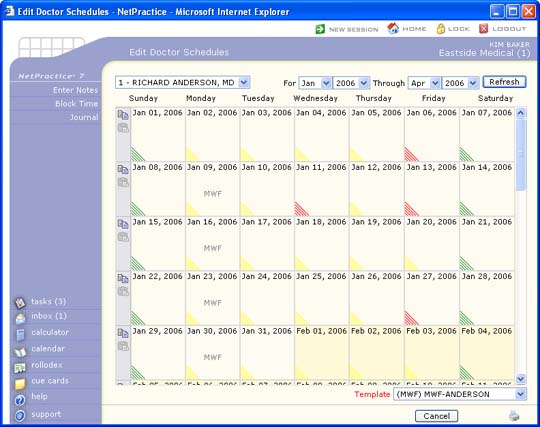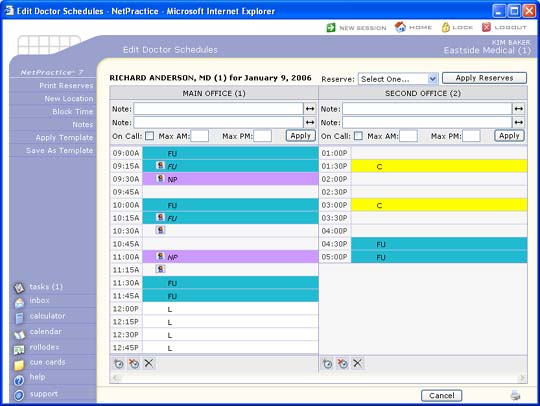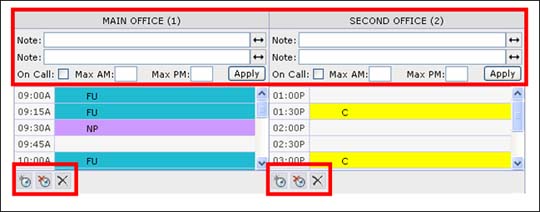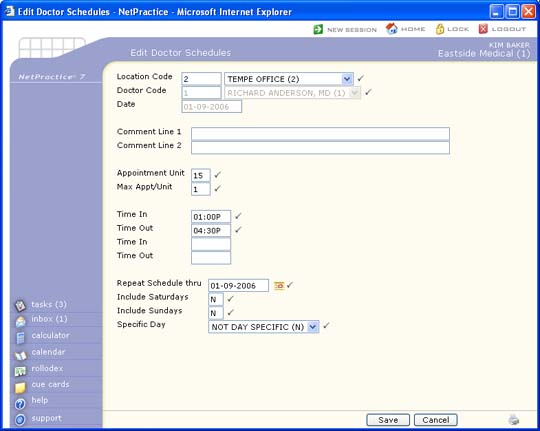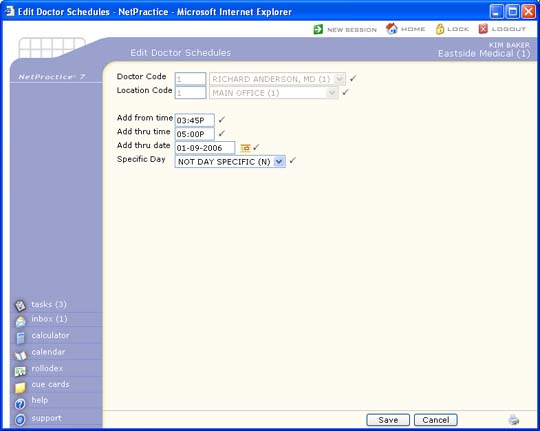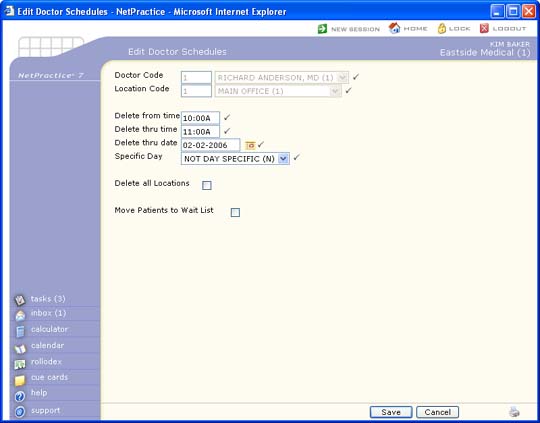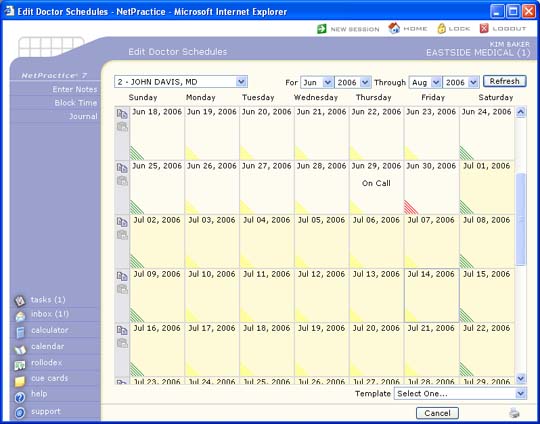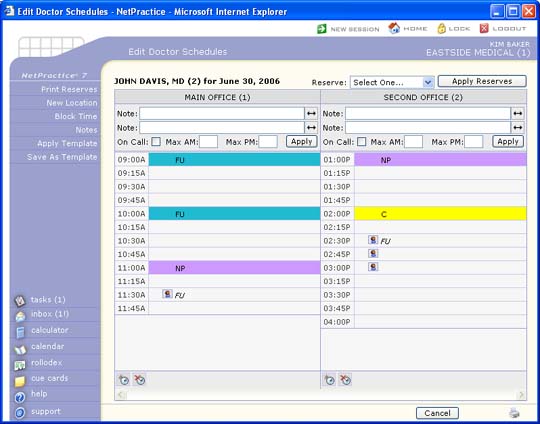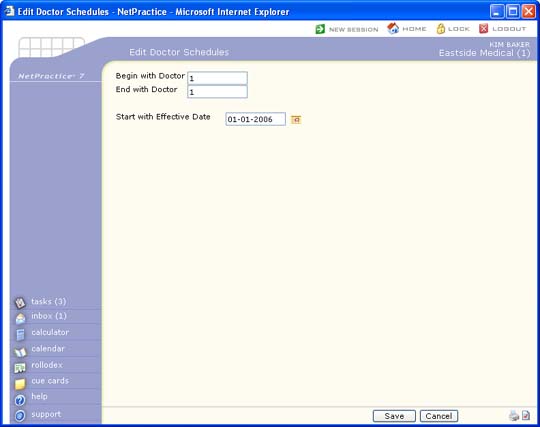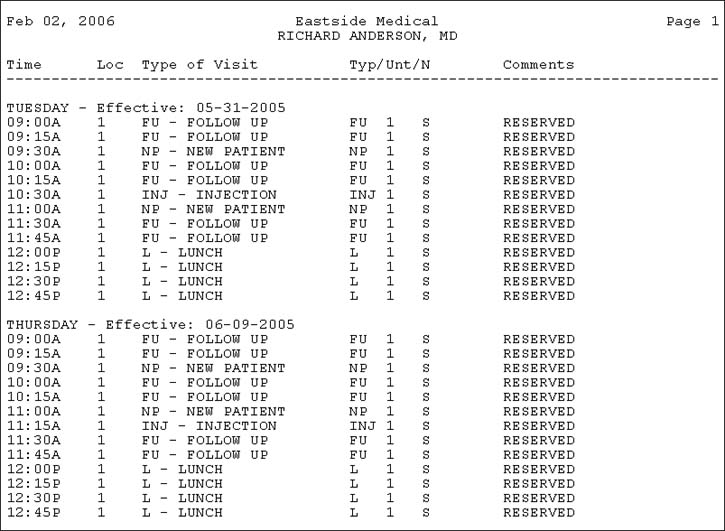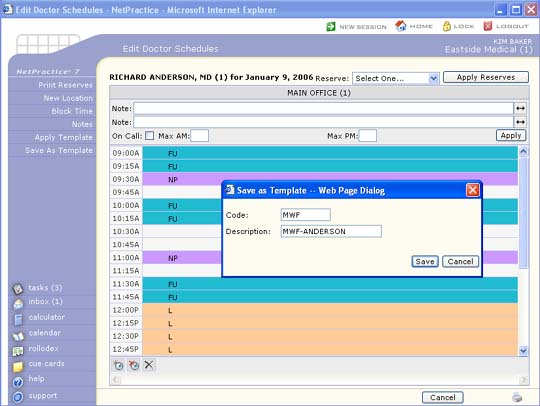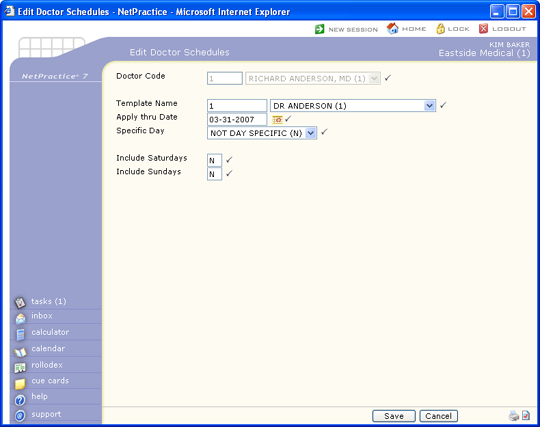| Prompt |
Response |
Req |
Len |
| Doctor(s) |
Select the Doctor(s) you want from the
Doctor list. If you want to select multiple non-contiguous doctor
codes, hold down the CTRL key while clicking each doctor, then
release CTRL. If you want to select a range of doctor codes, click
on the first code to select it, scroll down to the last code in
the range, hold down the SHIFT key and click on the last code. |
 |
5 |
| Location(s) |
Select the Location(s) you want from
the Location list. If you want to select multiple non-contiguous
location codes, hold down the CTRL key while clicking each location,
then release CTRL. If you want to select a range of location codes,
click on the first code to select it, scroll down to the last
code in the range, hold down the SHIFT key and click on the last
code. |
 |
8 |
| Note |
Type the text for the Note. |
|
50 |
| Note |
Type additional text for the Note if
needed. |
|
50 |
| From Date |
Type the date you want to start entering
Notes in the schedule or click the calendar icon to select a date. |
|
10 |
| Thru Date |
Type the date you want to stop entering
Notes in the schedule or click the calendar icon to select a date. |
|
10 |
| Overwrite existing Note |
If you want to overwrite any existing
Notes, select this check box. |
 |
1 |
| Prompt |
Response |
Req |
Len |
| Block or Unblock |
Select the option you want to either
block or unblock timeslots on the schedule. |
|
1 |
| Doctor(s) |
Select the Doctor(s) you want from the
Doctor list. If you want to select multiple non-adjacent doctor
codes, press and hold the CTRL key and click each code you want
to include. If you want to select a range of doctor codes, click
the first code in the range, scroll down to the last code in the
range, press and hold the SHIFT key and click the last code in
the range. To select all codes, click the first code in the list,
scroll down to the last code, press and hold the SHIFT key and
click the last code in the list. |
 |
8 |
| Location(s) |
Select the Location(s) you want from
the Location list. If you want to select multiple non-adjacent
doctor codes, press and hold the CTRL key and click each code
you want to include. If you want to select a range of location
codes, click the first code in the range, scroll down to the last
code in the range, press and hold the SHIFT key and click the
last code in the range. To select all codes, click the first code
in the list, scroll down to the last code, press and hold the
SHIFT key and click the last code in the list. |
 |
8 |
| From Date |
Type the date you want to start blocking/unblocking
time in the schedule or click the calendar icon to select a date. |
|
10 |
| Thru Date |
Type the date you want to stop blocking/unblocking
time in the schedule or click the calendar icon to select a date. |
|
10 |
| From Time |
Type the time you want to start blocking/unblocking
time in the schedule. |
 |
6 |
| Thru Time |
Type the time you want to stop blocking/unblocking
time in the schedule. |
 |
6 |
| Specific Day |
Select the day you want from the Day
list. |
 |
2 |
| Move Patients to Wait List |
If you want to remove appointments and
place them in the Wait List, select this check box, otherwise
the appointments will remain in the schedule. |
 |
1 |
| Comment |
Type any text needed explaining the
reason for Blocking or Unblocking time. For example, 'ER Mtg'.
This text will display as a Note in the first appointment time
slot that is Blocked. |
|
40 |
| Prompt |
Response |
Req |
Len |
| Location Code |
Type the location code you want or select
from the Location list. |
 |
5 |
| Doctor Code |
This field is for informational purposes
only. The Doctor you selected in the Monthly Scheduling Edit screen
will display. |
 |
5 |
| Date |
This field is for informational purposes
only. The Date you selected in the Monthly Scheduling Edit screen
will display. |
 |
10 |
| Comment Line 1 |
Type the text for the Note, if needed. |
|
50 |
| Comment Line 2 |
Type the text for any additional Note,
if needed. |
|
50 |
| Appointment Unit |
Type the number of minutes you want
to be allocated for each appointment unit in the schedule. This
value will automatically default from the Appointment Unit
field in the Scheduling System Integration function and
can be changed as needed. |
 |
2 |
| Max Appt/Unit |
Type the maximum number of appointments
(units) that can be scheduled in a time slot. This value will
automatically default from the Max Appt/Unit field in the
Scheduling System Integration function and can be changed
as needed. This field is used to determine when a time slot is
being overbooked and controls the number of Reserves (up to a
maximum of four) that can be applied to one time slot in the Edit
Doctor Schedule function. |
 |
2 |
| Time In |
Type the Time you want the schedule
to start with followed by 'A' for A.M. or 'P' for P.M. For example,
08:00A. If you do not type the 'A' or 'P' after the time, CGM
webPRACTICE will automatically default to one of them based on
the 'most common usage' for the time selected. |
 |
6 |
| Time Out |
Type the Time you want the schedule
to stop followed by 'A' for A.M. or 'P' for P.M. For example,
11:30A. If you do not type the 'A' or 'P' after the time, CGM
webPRACTICE will automatically default to one of them based on
the 'most common usage' for the time selected. |
 |
6 |
| Time In |
If you are allowing for a break in the
schedule, type the Time you want the schedule to start back up
followed by 'A' for A.M. or 'P' for P.M. For example, 12:00P.
If you do not type the 'A' or 'P' after the time, CGM webPRACTICE
will automatically default to one of them based on the 'most common
usage' for the time selected. |
|
6 |
| Time Out |
If you allowed for a break in the schedule
and have specified a second Start time, type the Time you want
the second section of the schedule to end at followed by 'A' for
A.M. or 'P' for P.M. For example, 05:00P. If you do not type the
'A' or 'P' after the time, CGM webPRACTICE will automatically
default to one of them based on the 'most common usage' for the
time selected. |
|
6 |
| Repeat Schedule thru |
Type the date you want to create schedules
through or click the calendar icon to select a date. |
 |
10 |
| Include Saturdays |
If you want to include Saturdays when
creating the schedule, select this check box. |
 |
1 |
| Include Sundays |
If you want to include Sundays when
creating the schedule, select this check box. |
 |
1 |
| Specific Day |
Select the Specific Day option you want
this new schedule created for, otherwise if you want it created
for every weekday, select Not Specific Day from the list. |
 |
2 |
| Prompt |
Response |
Req |
Len |
| Doctor Code |
This field is for informational purposes
only. The Doctor you selected will display. |
 |
3 |
| Location Code |
This field is for informational purposes
only. The Location you selected will display. |
 |
3 |
| Add from Time |
Type the Time you want to start adding
to the schedule followed by 'A' for A.M. or 'P' for P.M. For example,
08:00A. If you do not type the 'A' or 'P' after the time, CGM
webPRACTICE will automatically default to one of them based on
the 'most common usage' for the time selected. |
 |
6 |
| Add thru Time |
Type the Time you want to stop adding
to the schedule followed by 'A' for A.M. or 'P' for P.M. For example,
05:00P. If you do not type the 'A' or 'P' after the time, CGM
webPRACTICE will automatically default to one of them based on
the 'most common usage' for the time selected. |
 |
6 |
| Add thru Date |
Type the date of the schedule you want
to add times through or click the calendar icon to select a date. |
 |
10 |
| Specific Day |
Select the Specific Day option you want
the new times added for, otherwise if you want them added for
every weekday, select Not Specific Day from the list. |
 |
2 |
| Prompt |
Response |
Req |
Len |
| Doctor Code |
This field is for informational purposes
only. The Doctor you selected will display. |
 |
4 |
| Location Code |
This field is for informational purposes
only. The Location you selected will display. |
 |
3 |
| Delete from Time |
Type the Time you want to start deleting
from the schedule followed by 'A' for A.M. or 'P' for P.M. For
example, 08:00A. If you do not type the 'A' or 'P' after the time,
CGM webPRACTICE will automatically default to one of them based
on the 'most common usage' for the time selected. |
 |
6 |
| Delete thru Time |
Type the Time you want to stop deleting
from the schedule followed by 'A' for A.M. or 'P' for P.M. For
example, 05:00P. If you do not type the 'A' or 'P' after the time,
CGM webPRACTICE will automatically default to one of them based
on the 'most common usage' for the time selected. |
 |
6 |
| Delete thru Date |
Type the date of the schedule you want
to delete times through or click the calendar icon to select a
date. |
 |
10 |
| Specific Day |
Select the Specific Day option you want
the times deleted for, otherwise if you want them deleted for
every weekday, select Not Specific Day from the list. |
 |
2 |
| Delete all Locations |
If you want the selected times deleted
for every location for the selected dates, select this check box. |
 |
1 |
| Move Patients to Wait List |
If you want to move any deleted patient
appointments to the Wait List, select this check box. If you select
this function, the patient appointment information will also be
moved into the Wait List. The only appointments that will not
automatically be moved to the wait list are patient appointments
that have Other selected for the New Patient Status
field in the appointment information, since those types of appointments
are generally used for meetings and other non-patient related
appointments. |
 |
1 |
| Prompt |
Response |
Req |
Len |
| Doctor Code |
This field is for informational purposes
only. The Doctor you selected will display. |
 |
4 |
| Template Name |
Type the template code you want or select
from the Template list. |
 |
10 |
| Apply thru Date |
Type the date you want to apply the
template through or click the calendar icon to select a date. |
 |
10 |
| Specific Day |
Select the Specific Day option you want
this template applied for, otherwise if you want it applied for
every weekday, select Not Specific Day from the list. |
 |
2 |
| Include Saturdays |
If you want to include Saturdays when
you apply this template, select this check box. |
 |
1 |
| Include Sundays |
If you want to include Sundays when
you apply this template, select this check box. |
 |
1 |


